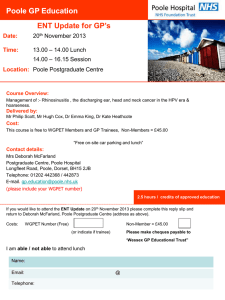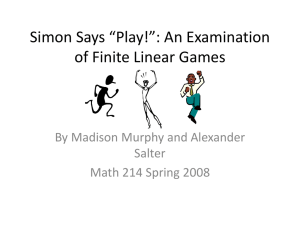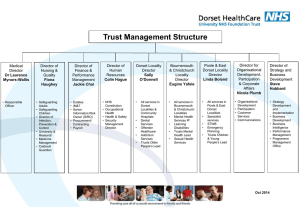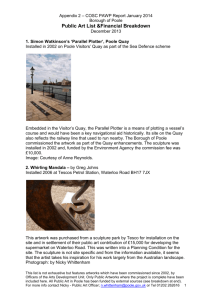PASS - Kentucky
advertisement
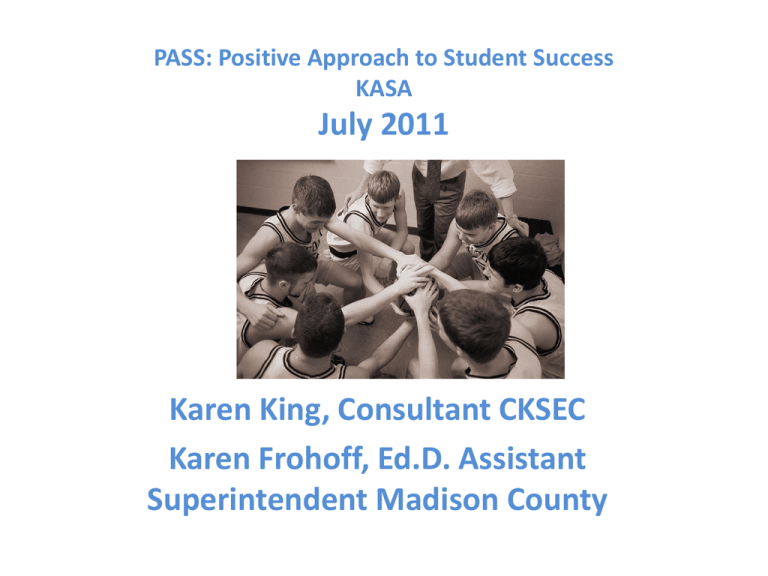
PASS: Positive Approach to Student Success KASA July 2011 Karen King, Consultant CKSEC Karen Frohoff, Ed.D. Assistant Superintendent Madison County Welcome PASS: Positive Approach to Student Success 2009-2010 Data A PBS approach to educational programming for students with behavioral and James R. Poole, B.A. emotional disorders Hope Caperton-Brown, Ed.D PASS • What is PASS – Process for managing the behavior of students identified as Behaviorally Disordered / Emotionally Disturbed that • is a non-levels / individualized approach • based on teaching behavioral expectations primarily in mainstream settings • utilizes daily behavioral evaluation software and weekly behavioral analysis to guide intervention using a FBA approach Caperton-Brown & Poole, 2008 4 PASS • Who participates in PASS? – “High-Risk” Students – Previous, less intensive interventions have been attempted but failed. Tertiary Level of Intervention Purpose: Reduce Harm Caperton-Brown & Poole, 2008 5 PASS and the PBS Intervention Continuum Tertiary 3-5% of students Targeted/ Intensive 7-10% of Students Secondary At-Risk Students Classroom/Small Group Strategies 85-90% of Students Primary School-wide/Universal Preventive Interventions Caperton-Brown & Poole, 2008 6 PASS: An alternative to level-system approach to services for ED/BD • PASS is – Inclusive • The majority of PASS services are delivered in the mainstream / inclusive setting. – Constructive • Focused on building environments and behavioral skills rather than punishment procedures. – Focused on behavioral education • Formal and informal delivery of social skills training – Positive Approach to behavior management emphasizing • Academic and behavioral success • Treating students with dignity and respect • Collaborative team efforts So that the student is provided a reasonable chance to succeed. Caperton-Brown & Poole, 2008 7 PASS Phase 1: Referral to Program Phase 2 Orientation Aftercare Or PASS Out Phase 3 Maintenance and Inclusion • How does PASS work? – It’s a process. Caperton-Brown & Poole, 2008 8 PASS : Referral to the Program • Activities – Identification of PASS candidates – Formal placement – Determination of Target Behavior(s)/Appropriate Interventions – Establishing PASS Team – Training Team Members Caperton-Brown & Poole, 2008 9 PASS: Referral to the program • Prior to placement … – Campus Responsibilities • Campus exhausts regular interventions/resources to address student’s behavior – Special Education Responsibilities • Student is recommended for PASS following behavior consult / documented intervention(s) • ARC convened • FBA & BIP developed – PASS Teacher Responsibilities • Form PASS Team • “scout” the student Caperton-Brown & Poole, 2008 10 PASS: Referral to the program The PASS Team • Membership – – – – – – – • Responsibilities Behavior Specialist PASS Teacher Classroom Teachers Assistant Principal Educational Diagnostician Counselor/LSSP Auxiliary Personnel – Delivery of services mandated by ARC – Refinement of BIP – FBA – Decision-making regarding ReOrientation/SelfMonitoring/Dismissal Caperton-Brown & Poole, 2008 11 PASS: Phase 2 - Orientation -Occurs within PASS classroom for individually determined period of time. (Range is several days to several weeks.) - PASS classroom is organized using CHAMPs model Caperton-Brown & Poole, 2008 12 PASS: Orientation • Activities – Instruction in PASS procedures • Monitoring system • Reward System • School-to-Home Note Responsibilities • Mainstream Classroom exit/re-entry procedures • Behavior Expectations for independent seatwork/cafeteria/hallway/ bus/restroom behavior Caperton-Brown & Poole, 2008 13 PASS: Orientation • Teaching Replacement Behavior – Individualized Social Skills Instruction – Step one: Develop T-chart – Step two: Teach / model replacement behavior (s) – Step three: Role-play scenerios – Drill, practice, and reward Caperton-Brown & Poole, 2008 14 PASS: Orientation • Sample T-chart Target (BIP) Behavior #1: Physical Aggression Examples of unacceptable behavior: Replacement behaviors: - hitting, kicking, fighting or wrestling - walking away - keeping hands and feet to self - biting, scratching or spitting - using words instead of actions -throwing objects - ignoring - seek an adult to mediate Caperton-Brown & Poole, 2008 15 PASS: Orientation • Activities (continued): – Academic instruction in core curricula provided by PASS teacher & by classroom teacher • Reduced amount of class work is generated by classroom teacher • PASS provides “content mastery”-like support of academics • Classroom teacher visits PASS to ensure teacher understands work assignment/discuss work and/ discuss rules of their specific class Caperton-Brown & Poole, 2008 16 PASS: Orientation • Activities (continued): – Elicitation of parent participation – Development of student portfolio – Structured Observation and Feedback Session Caperton-Brown & Poole, 2008 17 PASS: Orientation • Structured Observation and Feedback Session – Arrangements are made with mainstream teachers for student observation of class – Student observes classroom for 15 minutes accompanied by PASS teacher with pre-planned agenda • • • • • When can you talk in this classroom? How do you ask for help? Do rules for behavior change with different activities? When is it o.k. to move around the room? What are the teacher’s expectations for student participation? – Immediately after observation, student and PASS teacher discuss student’s observations Caperton-Brown & Poole, 2008 18 PASS: Phase 3 Maintenance & Inclusion Frequent monitoring To Selfmonitoring Caperton-Brown & Poole, 2008 19 PASS: Phase 3 • Activities – “Readiness” Criteria for Phase 3 – “Marketing” the PASS Student – Monitoring – Re-Direction of Inappropriate Behavior – Re-Orientation – Self-Monitoring Caperton-Brown & Poole, 2008 20 PASS: Phase 3 Readiness • Transition to Phase 3 – Student demonstrates understanding of • PASS Procedures • Replacement Behaviors • Expectations of Mainstream Classroom(s) – Affective control is demonstrated Caperton-Brown & Poole, 2008 21 PASS: Phase 3 – Monitoring student behavior • monitoring tokens are utilized by classroom teacher to identify 3 levels of acceptability of student behavior • PASS teacher/paraprofessional record level of behavior at monitoring time and use data to further the functional assessment of target behavior • behavior at the warning or unacceptable level is re-directed Caperton-Brown & Poole, 2008 22 PASS: Phase 3 • Monitoring Tokens Behavior is Acceptable Warning: Behavior is unacceptable. Student has been given warning and compliance is expected in 1-2 minutes. Behavior is continues to be unacceptable after reasonable period of time to comply. Bonus: Student has performed above and beyond expectations. Caperton-Brown & Poole, 2008 23 PASS: Phase 3 • What behaviors do we monitor? Only behaviors targeted for intervention by the student’s BIP are monitored! Caperton-Brown & Poole, 2008 24 PASS: Phase 3 • Functional Analysis – Behavior analysis (from monitoring data) is reviewed weekly and guides … • Reinforcement • Intervention • Monitoring schedule Caperton-Brown & Poole, 2008 25 PASS: Phase 3 The Reward System • Students earn rewards by … – Accumulating mastery credit for “acceptable behavior” in areas identified on BIP/documented on monitoring sheets – Return of parent note – Bonus points for demonstrating behavior that is above expectations • Thursday to Thursday Week • Rewards delivered on Friday Caperton-Brown & Poole, 2008 26 PASS: Phase 3 • Re-Direction Procedure – PASS teacher prompts: • What’s going on? (Check out student’s story if it differs from teachers.) • What led up to this? • How could you have handled this differently? (replacement behavior) • What are you going to do when you return to the classroom? • What will be consequences of that action? Caperton-Brown & Poole, 2008 27 PASS: Phase 3 • Re-Orientation/Revolving Door Approach – Occurs when • A student repeatedly displays an inability to successfully perform target behaviors in a specific setting • Student engages in high level misbehavior that is a danger to himself or others – Activities • Intensive social skills training in problematic target behavior • Structured observation/feedback session in problematic setting • Academic instruction – Student returns to inclusion setting when • Successfully performs replacement behavior for misbehavior • Affective control is demonstrated Caperton-Brown & Poole, 2008 28 PASS: Phase 3 • Self-Monitoring – Occurs • After a student has demonstrated a prolonged (i.e., one semester to one school year) period of success on target behaviors and there are no other misbehaviors that significantly interfere with academic success – Activities • Student and teacher use monitoring forms to assess targeted BIP behaviors • Behavior Analysis continues with student’s participation – Dismissal from PASS • Considered after student demonstrates a prolonged period of success on target/BIP behaviors and there are no other misbehaviors that significantly interfere with academic success Caperton-Brown & Poole, 2008 29 PASS: Aftercare • “PASS Out” – 12-step model • provides continuing support for behavior maintenance for graduates • provides peer mentorship to new PASS students – PASS graduates serve as mentors to new PASS students – PASS teacher provides supervision of mentorship relationships Caperton-Brown & Poole, 2008 30 PASS • PASS in a nutshell… – Non-levels, Inclusion approach – Focus on constructing new behaviors – Functional analysis of behavior supported by daily data collection and analysis – Reward-based system Caperton-Brown & Poole, 2008 31 PASS • Initiating PASS requires .. – 3 day training including • • • • PASS teacher PASS paraprofessional Campus administrator (s) – (Day 1 only) Behavior program supervisor (s) – First year commitment to consultation by PASS personnel – Resources including: • • • • PASS Manual PASS software Social skills curriculum CHAMPs materials Caperton-Brown & Poole, 2008 32 COLLABORATION Regular Education Teacher and Pass Teacher * Communication + Consistency = Student Success * Every Adult/Professional Must Be On The Same Page To Help OUR Students Be Successful! What is the data saying! PASS District and School Participation 21 School Districts in Kentucky 64 Total Schools 20 Elementary Schools 24 Middle Schools 20 High Schools Disability Distribution Race (Available by Count and Percentage) KY Pass Behavior Program Summary • Approximately 580 KY PASS students. • Representation from 6 Cooperatives, 20+ Districts, 52 Schools and 212 Users. 70 60 66 58 50 40 33 61 60 54 30 21 20 10 7 23 28 22 32 0 19 Grade Level Participation 80 74 69 69 70 60 56 60 50 40 34 36 31 25 30 26 24 20 20 10 8 0 # Students 14 Data Behavior Tracker Monthly District Suspensions Madison County 2007-2009 (5 Schools) 2009-2010 (6 Schools) 140 120 100 2007-2008 2008-2009 2009-2010 2010-2011 80 60 40 20 0 Aug Nov Feb May/June Madison Central Suspension Rates 45 40 35 30 25 20 15 10 5 0 2007-2008 2008-2009 2009-2010 2010-2011 Aug Nov Feb May/June Madison Southern Suspension Rates 70 60 50 2007-2008 2008-2009 2009-2010 2010-2011 40 30 20 10 0 Aug Nov Feb May/June Clark Moores Middle Suspension Rates 25 20 2007-2008 2008-2009 2009-2010 2010-2011 15 10 5 0 Aug Nov Feb May/June Madison Middle Suspension Rates 40 35 30 25 2007-2008 2008-2009 2009-2010 2010-2011 20 15 10 5 0 Aug Nov Feb May/June Foley Middle Suspension Rates 20 18 16 14 12 10 8 6 4 2 0 2007-2008 2008-2009 2009-2010 2010-2011 Aug Nov Feb May/June B. Michael Caudill Suspension Rates 12 10 8 2009-2010 2010-2011 6 4 2 0 Aug Nov Feb May/June OSS Comparisons 2007-2011 Trending in Out of School Suspensions Trending in Out of School Suspensions Trending for In School Suspensions Trending for In School Suspensions Unexcused Absences Trending in Office Referrals Trending in Office Referrals Trending for Physical Restraints Top 10 1. Warning/Off task 2. Warning/Failure to follow directions 3. Warning/Not completing work 4. Excused Absence/Non-Targeted 5. School Holiday/Full Day 6. Warning/Non-Targeted 7. OSS 8. School Closing 9. Warning/Disrespectful to peer 10. Warning/Disruption of class Dunbar High Dunbar Allen Co High Allen Co High Clark County OSS Clark County ISS Clark County Office Referrals SAMPLE DATA TRACKER Sample Student Data Dec to Jan Sample Student Data Jan to Feb Student Self-Monitoring Following Directions by month 35 30 Number of intervals 25 20 15 10 5 0 Aug Sept Oct Nov Dec Jan Months of year Yellows Reds Feb Mar Apr May Following Directions Analysis by Student • Trend is that more reds at the beginning of the year. More yellows, less reds toward the end of the year. • Means I am getting better at following directions. Because now when I go to yellow I fix it rather than have to go to red to get it fixed. • I follow directions best from, Ms. Gullett, Mr. Gullett, Ms. Combs, Ms. Berry, • People I still tend to ignore: Ms. Sipes, Ms. Fox, Ms. Hollon, • Goal: keep reds under 10 a month and get yellows down to 10 a month or less. Expressing Emotions Correctly 7 6 Number of Intervals 5 4 3 2 1 0 Oct Nov Dec Jan Feb Months of year Yellows Red Mar Apr May Expressing Emotions Analysis • Think that Christmas may have gotten me excited and caused increase in Dec. • Reds under five whole year. That’s really good • Goal: to keep these numbers low and use please more. • Cue cards to help when in classroom. Tantrums 18 16 14 Number of intervals 12 10 8 6 4 2 0 Nov Dec Jan Feb Mar Month of year Yellow Red Apr May Tantrum Analysis • Tantrums have basically disappeared. • Think they went away cause I am learning self control. • I still have to do what I am asked so tantrum doesn’t work to get me out of work. • Instead of throwing a tantrum, I will read, color, or ask the teacher to make a deal on work and reward. • Goal: No tantrums. Total Intervals 180 160 140 number of intervals 120 100 80 60 40 20 0 Aug Sept Oct Nov Dec Jan Months of year Yellows Red Suspensions Feb Mar Apr May Total Interval Analysis • Over all, number of reds and yellows has gone down for the year. • Have not been suspended since September. • November was elevated because of getting tonsils out and being stressed about coming surgery. • My scores started getting better when new teacher came in October. (Ms. Gullett). Monthly Percentage 120% 100% Percentage 80% 60% 40% 20% 0% Aug Sept Oct Nov Dec Jan Month Feb Mar Apr May Monthly Percentage Analysis • Percentage has increased over the year. • There was a jump in October when Ms. Gullett came. • Also started spending most of day in PASS in October. • Have moved back out to class more in March and April but percentages have stayed high. Things I have learned… • If I ask I usually get what I want better than when I throw a fit. • It is better to get it done quicker so I can have reward than losing time arguing over everything. • I am going to have to do the work whether I throw fit or not, so just do it and get it done. • People like it when you ask before you touch.
